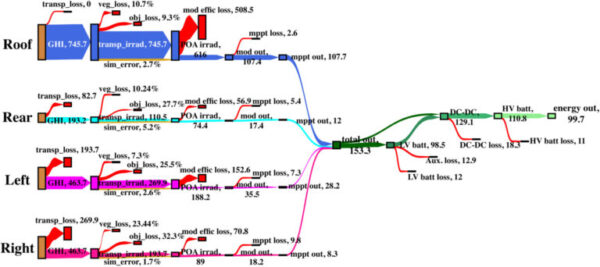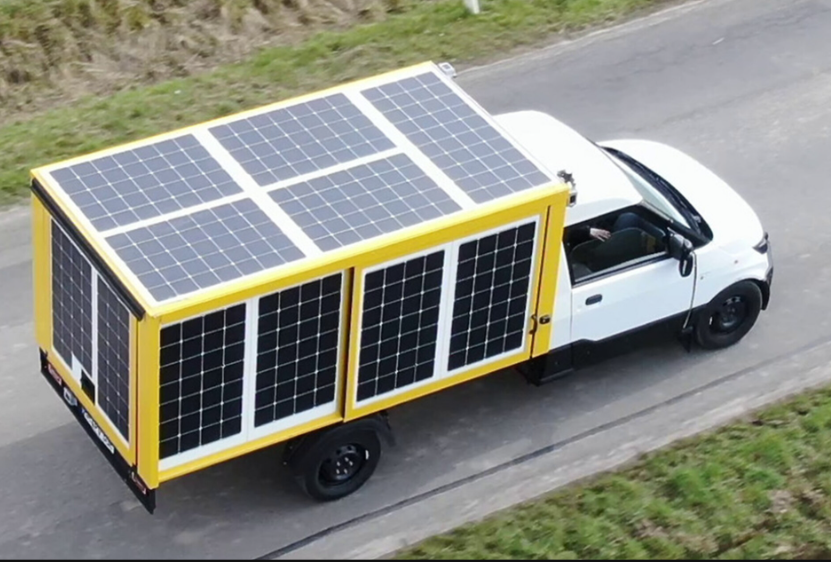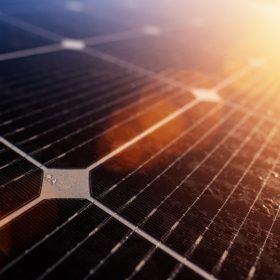Researchers from Germany and the Netherlands have mounted PV modules on a light commercial electric vehicle (EV) and measured its performance over four months.
During this time, the EV made daily 45 minutes trips from a researcher’s home in the area of Germany’s Hannover to the Institute for Solar Energy Research Hamelin (ISFH), remained parked there for a few hours, and then returned home in the afternoon for the remainder of the daytime before being taken inside for charging from the grid.
“This work is a continuation of a past paper in which an energy flow analysis of the collected data for a single exemplary day was presented. Here, we present a more detailed and statistically sound analysis over a long period of 4 months from April to July 2021,” the scientists said. “The focus will be on individual components in the system, such as PV modules, MPPTs, low voltage (LV) buffer battery, DC-DC converter, high voltage (HV) vehicle traction battery, and the overall losses occurring in the system.”
The EV itself is based on the StreetScooter model Work L. The peak power of the M2 wafer silicon PV modules was 2,180 W, with 875 W on the roof, 215 W on the rear side, and 545 W on the left and right sides. The roof modules were individually connected to 5 separate MPPTs, while in the rest of the EV, every two modules were connected in series to a single MPPT tracker. All the MPPTs were connected to the LV battery and the DC-DC converter, which supplied the power to the vehicle’s HV battery.
“The vehicle’s front side faces North-West at both locations, but at ISFH, the parking is in the morning when the sun rises, and at home, the sun is setting,” the academics said. “The rear side has a similar irradiance profile at both parking locations, as the vehicle orientation is almost identical. During the driving phase, since the vehicle orientation continuously varies relative to the sun, and due to obstruction from surrounding objects, the rear, left, and right sides receive relatively less irradiance.”

Photo: Institute of Energy, Materials and Devices - Photovoltaics (IMD-3), Progress in Photovoltaics, CC BY 4.0
Based on their measurements, the parking duration was around 106.7 and 382.22 hours for the ISFH and home parking, respectively. A combined total of 49.06 kWh for ISFH parking and 153.32 kWh for home parking was available after the MPPT conversion stage. Out of that, 29.16 kWh (ISFH) and 98.57 kWh (home) charged the LV battery, 19.9 kWh (ISFH) and 54.75 kWh (home) were transferred directly to the DC-DC converter, and 5.96 kWh (ISFH) and 12.92 kWh (home) were the auxiliary consumption loss of the system.
“The LV side of the DC-DC converter receives 38.73 kWh (ISFH) and 129.18 kWh (home), which is sent to the HV battery. After considering the losses in the HV battery, the usable energy for traction is 29.65 kWh (ISFH) and 99.74 kWh (home),” they added. “At the driving phase, the PV module produced 9.8 kWh of electricity at an 18.01% conversion efficiency. After the MPPT conversion stage, 8.3 kWh of electricity is available for the further stages, out of which 4.3 kWh charges the LV battery and 4 kWh is directly provided to the DC-DC converter. The final output of the DC-DC converter is 5.5 kWh, which is transferred to the vehicle’s HV battery during the driving phase.”
The overall system efficiency, considering multiple power conversion stages, battery charging/discharging losses, and auxiliary losses, was found to be 60.44% for ISFH parking, 65.05% for home parking, and 66.26% for trips. Based on the average consumption per kilometer of all trips and the total PV energy injected into the battery, the team estimated that the PV electricity contributed 530 km to the range of the EV over the measured period, which is 30% of the total distance of 1750 km.
Their findings were presented in “Performance Analysis of an Onboard PV System on a Demonstrator Light Commercial Vehicle in Hannover, Germany,” published in Progress in Photovoltaics. Scientists from Germany’s Institute of Energy, Materials and Devices – Photovoltaics (IMD-3), Institute for Solar Energy Research Hamelin (ISFH), and the Netherlands Eindhoven University of Technology have conducted the study.
This content is protected by copyright and may not be reused. If you want to cooperate with us and would like to reuse some of our content, please contact: editors@pv-magazine.com.








By submitting this form you agree to pv magazine using your data for the purposes of publishing your comment.
Your personal data will only be disclosed or otherwise transmitted to third parties for the purposes of spam filtering or if this is necessary for technical maintenance of the website. Any other transfer to third parties will not take place unless this is justified on the basis of applicable data protection regulations or if pv magazine is legally obliged to do so.
You may revoke this consent at any time with effect for the future, in which case your personal data will be deleted immediately. Otherwise, your data will be deleted if pv magazine has processed your request or the purpose of data storage is fulfilled.
Further information on data privacy can be found in our Data Protection Policy.